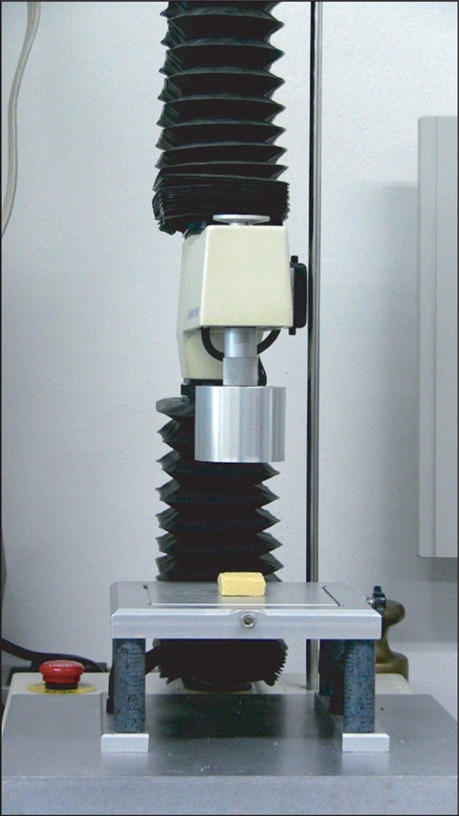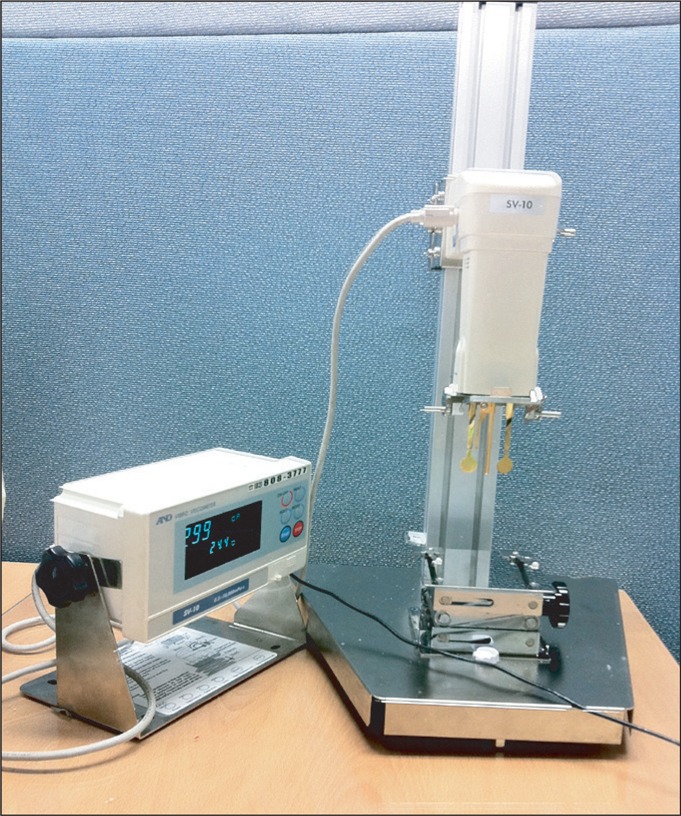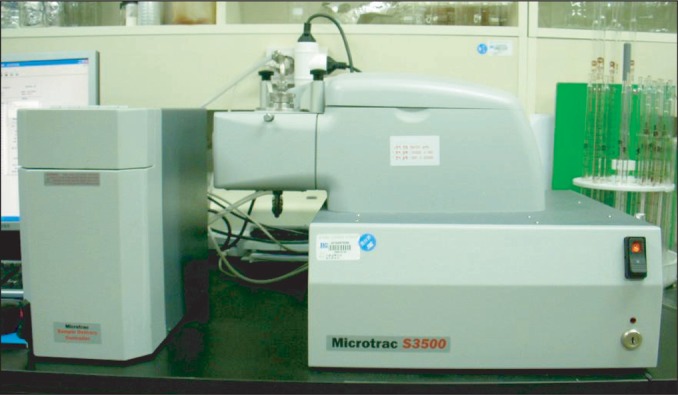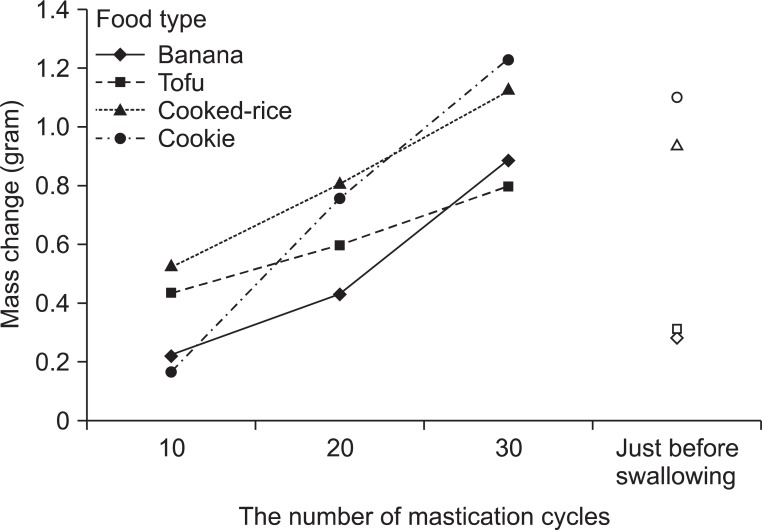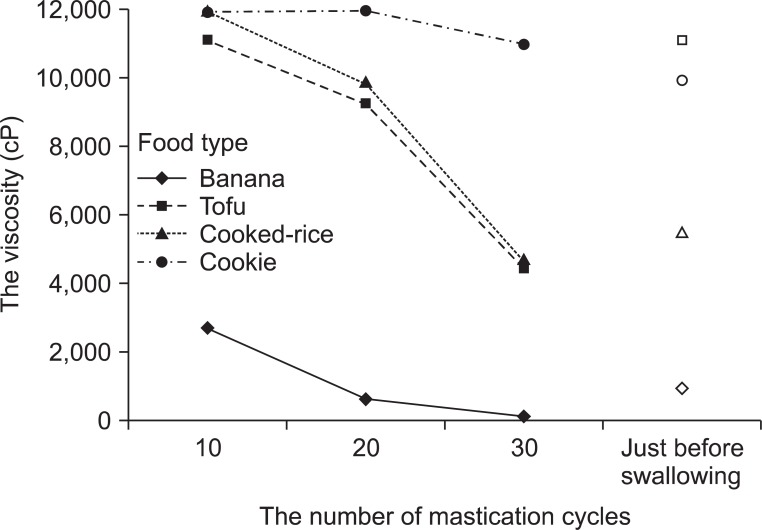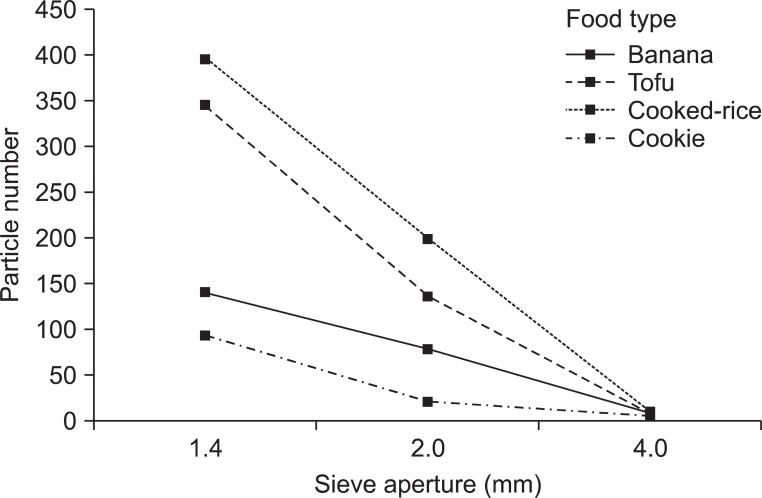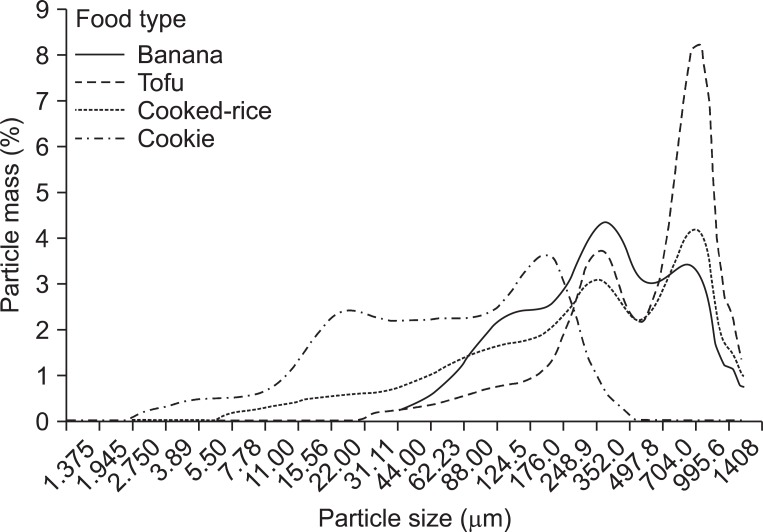Ann Rehabil Med.
2012 Dec;36(6):776-784.
The Effect of Rheological Properties of Foods on Bolus Characteristics After Mastication
- Affiliations
-
- 1Department of Physical Medicine & Rehabilitation, Chung-Ang University College of Medicine, Seoul 156-755, Korea. donkim21@gmail.com
- 2Department of Food Engineering, Dankook University College of Engineering, Cheonan 330-715, Korea.
- 3Department of Food & Nutrition, Chung-Ang University College of Human Ecology, Seoul 156-755, Korea.
Abstract
OBJECTIVE
To evaluate the effects of physical properties of foods on the changes of viscosity and mass as well as the particle size distribution after mastication. METHOD: Twenty subjects with no masticatory disorders were recruited. Six grams of four solid foods of different textures (banana, tofu, cooked-rice, cookie) were provided, and the viscosity and mass after 10, 20, and 30 cycles of mastication and just before swallowing were measured. The physical properties of foods, such as hardness, cohesiveness, and adhesiveness, were measured with a texture analyzer. Wet sieving and laser diffraction were used to determine the distribution of food particle size.
RESULTS
When we measured the physical characteristics of foods, the cookie was the hardest food, and the banana exhibited marked adhesiveness. Tofu and cooked-rice exhibited a highly cohesive nature. As the number of mastication cycles increased, the masses of all foods were significantly increased (p<0.05), and the viscosity was significantly decreased in the case of banana, tofu, and cooked-rice (p<0.05). The mass and viscosity of all foods were significantly different between the foods after mastication (p<0.05). Analyzing the distribution of the particle size, that of the bolus was different between foods. However, the curves representing the particle size distribution for each food were superimposable for most subjects.
CONCLUSION
The viscosity and particle size distribution of the bolus were different between solid foods that have different physical properties. Based on this result, the mastication process and food bolus formation were affected by the physical properties of the food.
Keyword
Figure
Reference
-
1. Woda A, Mishellany A, Peyron MA. The regulation of masticatory function and food bolus formation. J Oral Rehabil. 2006; 33:840–849. PMID: 17002744.
Article2. Mishellany A, Woda A, Labas R, Peyron MA. The challenge of mastication: preparing a bolus suitable for deglutition. Dysphagia. 2006; 21:87–94. PMID: 16703445.
Article3. Ranawana V, Monro JA, Mishra S, Henry CJ. Degree of particle size breakdown during mastication may be a possible cause of interindividual glycemic variability. Nutr Res. 2010; 30:246–254. PMID: 20534327.
Article4. Lund JP. Mastication and its control by the brain stem. Crit Rev Oral Biol Med. 1991; 2:33–64. PMID: 1912143.
Article5. Takahashi T, Miyamoto T, Terao A, Yokoyama A. Cerebral activation related to the control of mastication during changes in food hardness. Neuroscience. 2007; 145:791–794. PMID: 17320301.
Article6. Steele CM, Miller AJ. Sensory input pathways and mechanisms in swallowing: a review. Dysphagia. 2010; 25:323–333. PMID: 20814803.
Article7. Prinz JF, Lucas PW. Swallow thresholds in human mastication. Arch Oral Biol. 1995; 40:401–403. PMID: 7639643.
Article8. Prinz JF, Lucas PW. An optimization model for mastication and swallowing in mammals. Proc Biol Sci. 1997; 264:1715–1721. PMID: 9447729.
Article9. Feldman RS, Kapur KK, Alman JE, Chauncey HH. Aging and mastication: changes in performance and in the swallowing threshold with natural dentition. J Am Geriatr Soc. 1980; 28:97–103. PMID: 7354209.
Article10. Peyron MA, Mishellany A, Woda A. Particle size distribution of food boluses after mastication of six natural foods. J Dent Res. 2004; 83:578–582. PMID: 15218050.
Article11. Helkimo E, Carlsson GE, Helkimo M. Chewing efficiency and state of dentition. A methodologic study. Acta Odontol Scand. 1978; 36:33–41. PMID: 273364.12. Van der Bilt A, Olthoff LW, Bosman F, Oosterhaven SP. The effect of missing postcanine teeth on chewing performance in man. Arch Oral Biol. 1993; 38:423–429. PMID: 8328923.
Article13. Buschang PH, Throckmorton GS, Travers KH, Johnson G. The effects of bolus size and chewing rate on masticatory performance with artificial test foods. J Oral Rehabil. 1997; 24:522–526. PMID: 9250840.
Article14. Jiffry MT. Analysis of particles produced at the end of mastication in subjects with normal dentition. J Oral Rehabil. 1981; 8:113–119. PMID: 6939801.
Article15. Lucas PW, Luke DA. Method for analysing the breakdown of food in human mastication. Arch Oral Biol. 1983; 28:813–819. PMID: 6579911.16. Jalabert-Malbos ML, Mishellany-Dutour A, Woda A, Peyron MA. Particle size distribution in the food bolus after mastication of natural foods. Food Quality and Preference. 2007; 18:803–812.
Article17. Mochizuki Y. Wrolstad RE, editor. Texture profile analysis. Current protocols in food analytical chemistry. 2001. New York: John Wiley & Sons Inc;p. H2.3.1–H2.3.7.
Article18. Logemann JA. Evaluation and treatment of swallowing disorder. 1998. 2nd ed. Austin: Pro-ed Inc;p. 314.19. Peyron MA, Lassauzay C, Woda A. Effects of increased hardness on jaw movement and muscle activity during chewing of visco-elastic model foods. Exp Brain Res. 2002; 142:41–51. PMID: 11797083.20. Steffe JF. Rheological methods in food process engineering. 1996. 2nd ed. East Lansing: Freeman Press;p. 1–93.21. Hoebler C, Devaux MF, Karinthi A, Belleville C, Barry JL. Particle size of solid food after human mastication and in vitro simulation of oral breakdown. Int J Food Sci Nutr. 2000; 51:353–366. PMID: 11103300.
- Full Text Links
- Actions
-
Cited
- CITED
-
- Close
- Share
- Similar articles
-
- EMG Activity of Masseter Muscles in the Elderly According to Rheological Properties of Solid Food
- Teeth, Malocclusion and Disordered Mastication: Evaluation and Treatment
- Functional Foods and Clinical Trial
- Rheological characterization of thermoplasticized injectable gutta percha and resilon
- Assessing Commercial CLEANBOLUS Based on Silicone for Clinical Use

